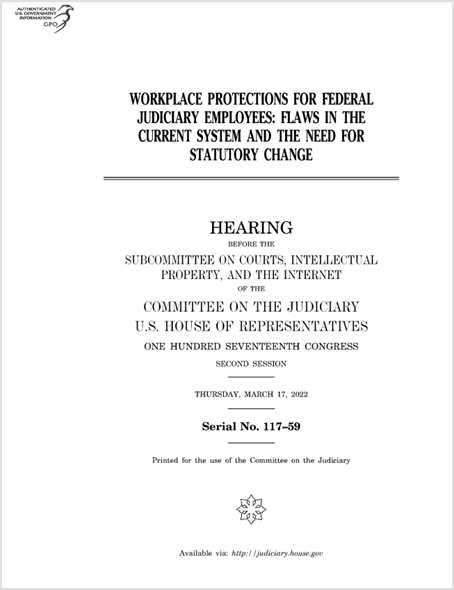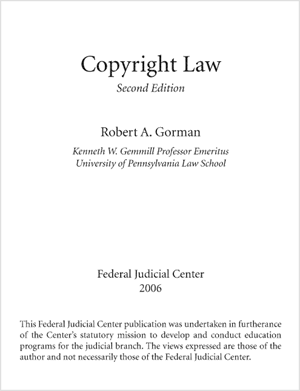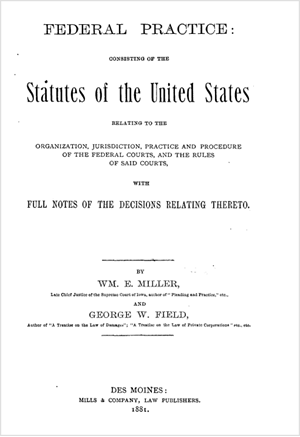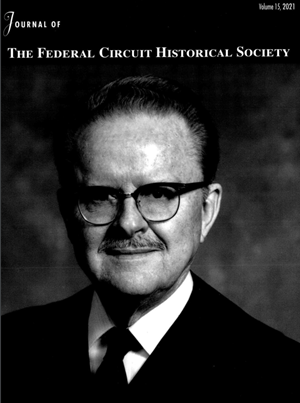
Judges and the Judiciary: Exploring America's Court System
A comprehensive compilation of resources that analyze how the complex web of judiciary structures, composition, oversight, procedures, and actions within America's court system touch the lives of everyday Americans.
3,666
TITLES
6,988
VOLUMES
2,424,141
PAGES
About Judges and the Judiciary: Exploring America's Court System
Judges and the Judiciary: Exploring America’s Court System compiles comprehensive resources that analyze the complex web of judiciary structures, composition, oversight, procedures, and actions within America’s court system. This database was originally built around Bernard D. Reams, Jr., et al.’s Congress and the Courts: A Legislative History, 1787-2018, which collected congressional documents related to the composition and structure of Article III Courts. While this important work is still prominently featured in the database, it is now supported and supplemented with content that dives into more complex philosophical issues concerning the judiciary, including the removal of judges and judicial ethics, especially in the wake of recent reports that highlighted lavish gifts bestowed upon Supreme Court justices.
Features
- Coverage of federal and state courts
- A Legislative History subcollection
- Enhanced faceting on search results
- 14 brand-new subjects and subject-coding of all titles
- Direct linking to our History of Supreme Court Nominations database
An Essential Resource
Comprehensive Coverage: This database is a one-stop resource for government documents, scholarly articles, books, and more exploring all aspects of America’s judiciary systems, with content updated regularly for the most up-to-date coverage.
Federal and State Content: Learn about the structure, creation, actions, and oversight of courts at both the state and federal levels.
Subject-Coding: To help guide users in their research, all titles within this database have been subject-coded, including 14 brand-new subjects.
Historical Context: Users can navigate through nearly 40 legislative histories and hundreds of Congressional Research Service (CRS) and Government Accountability Office (GAO) reports, hearings, and federal rules, providing essential historical context to understand the evolution of the American court system.
Federal Judicial Center Archive: Access the complete archive of publications from the Federal Judicial Center, which is the primary education and research agency for the federal courts. This inclusion provides more than 700 publications consisting of valuable educational and research materials related to the federal judiciary.
Rich Diversity of Content: Round out your research with thousands of handpicked, highly cited scholarly articles that cover topics ranging from court jurisdiction to judicial power, ideologies, and the makeup of the judiciary. Want to take your research further? We’ve also compiled more than 1,400 related works to explore.
Title List: KBART (TXT) | CSV | HTML
Featured Content
Content will continue to be added regularly!
When this database initially launched, it was built around Bernard D. Reams, Jr., et al.’s Congress and the Courts: A Legislative History, 1787-2018, a collection of congressional documents that examine the composition and structure of Article III Courts.
Article III of the U.S. Constitution states:
“The judicial power of the United States, shall be vested in one Supreme Court, and in such inferior courts as the Congress may from time to time ordain and establish. The judges, both of the supreme and inferior courts, shall hold their offices during good behaviour, and shall, at stated times, receive for their services, a compensation, which shall not be diminished during their continuance in office.”
Article III courts are:
- The Supreme Court
- The 13 U.S. appellate courts
- The 94 U.S. district courts
This legislative history is vital to understand the role of Congress in administering and interacting with Article III Courts. The legislative history consists of more than 70 volumes and is divided into seven parts that users can browse:
- Court of Appeals
- Creation and Growth of the Federal Judiciary
- Federal Courts
- Judges and Judicial Conduct
- Other Courts
- Proposed Reforms and Emerging Issues
- Supreme Court
This collection contains more than 600 hearings, nearly 500 CRS reports, and nearly 100 GAO reports that explore issues relating to judicial nominations, limits to judicial power, court authority, court studies, and much more.
Some hearings you may want to check out include:
- Administration of the Federal Judiciary (1991)
- Limit the Power of Judges of United States Courts (1924)
- Workplace Protections for Federal Judiciary Employees: Flaws in the Current System and the Need for Statutory Change (2022)
Some reports of note include:
- Administrative Office of the U.S. Courts: History, Operations, and Current Issues (2004)
- Questioning Judicial Nominees: Legal Limitations and Practice (2018)
- Standards for Admission To Practice in the Federal Courts (1979)

Explore the entire archive (more than 700 titles!) of publications from the Federal Judicial Center, the education and research agency for the federal courts. The Federal Judicial Center is responsible for conducting policy research and offering a variety of continuing education resources for employees within the judicial branch. Additionally, it collects and creates resources that detail the history of the U.S. judicial branch.
The Center was established by Congress in 1967, and its governing board is chaired by the Chief Justice of the United States.

Federal Rules are the rules established by Congress to govern proceedings within civil and criminal trials in U.S. federal courts. Included within this database are more than 375 rules that:
- include guidelines on criminal and civil procedure, bankruptcy, appellate procedure, and more.
- date back to the early 1900s, allowing users to see how these guidelines have changed over time.
- are periodically amended by Congress to reflect changes in the legal system and to improve their efficiency and fairness.

CFR and U.S. Code
This database includes easy access to the entirety of related sections of U.S. federal statutes, including:
- Code of Federal Regulations (CFR) Title 28: Judicial Administration
- U.S. Code Title 18: Crimes and Criminal Procedure
- U.S. Code Title 28: Judiciary and Judicial Procedure
Legislative Histories
Dive into nearly 40 legislative histories dedicated to American judicial systems, including titles such as:
- Judicial Improvements and Access to Justice Act of 1988
- Legislative History of Accommodations for the Judges’ of the U.S. Court of Appeals, P.L. 95-196
- Legislative History of the Judicial Disqualification Act P.L. 93-512
Our editors have hand-picked thousands of historical and current publications relevant to the American judiciary and valuable to any researcher exploring the U.S. court system. For example, explore 30 periodicals, including:
- Federal Circuit Bar Journal
- Federal Courts Law Review
- Journal of Federal Circuit Historical Society
- Judicature
Additionally, we have selected hundreds of scholarly articles that users can sort by title, author, number of citations, or year published, as well as search by title or author.
Dive into more than 1,400 works related to the American judiciary, including essential titles such as:
- Administrative Agencies and the Courts
- Federal Appointments Process: A Constitutional and Historical Analysis
- Geographical Boundaries of the Several Judicial Circuits: Recommendations for Change
- Risk of Personal Liability for Federal Judges (2nd ed.)

Subject-Coded Content for Simplified Searching
To help users target their research, HeinOnline editors have created 14 new subjects based on the subject matter of the titles in the collection. Explore these new subjects relating to America’s court system and their scope below:
Appellate courts, or a court of second instance, is any court that hears appeals from trial courts. It reviews the case and decides whether it agrees with the lower court’s decision.
This subject explores issues such as judicial term limits, mandatory retirement, revisions to procedure, and other changes to courts’ daily business.
Step into the witness stand and go inside real cases.
This subject explores technology in the courtroom and the ethics, changes, and challenges it brings, from televising trials to defendants appearing over Zoom.
District courts, also known as trial courts, fall at the bottom of the judicial hierarchy. They resolve a variety of disputes and render decisions.
This subject explores the minutia of keeping courts running, from staffing, clerks, paperwork, and the processes that aid in dispensing justice.
This subject covers judicial benefits, such as healthcare, salary, pensions, and more.
This subject covers processes in place (or not in place) to ensure judicial impartialness and that trials are conducted fairly.
This subject covers judicial appointments, elections, and the creation of additional judgeships.
This subject specifically deals with juvenile justice and family court matters.
The various federal rules govern proceedings in courts, such as the admissibility of evidence. Learn about the ins and out of court proceeding.
While much of the content in this database covers the federal court system, users can easily access content on state-specific courts with this subject.
As intermediate appeals courts, the U.S. Courts of Appeals hears appeals from U.S. district courts. Learn about their work and functions.
The Supreme Court of the United States is the highest court in the country. Use this subject to learn about the Court’s mighty power.
Understanding the U.S. Court System
The judicial branch of the federal government is responsible for determining the constitutionality of federal laws and resolving disputes about federal laws. Their rulings are enforced (or not enforced) by the executive branch. There are two courts systems in the United States—the federal court system and the state court system, which includes your municipal and local courts. There are three primary types of federal courts:
- 94 district courts or trial courts, which are organized based on state boundaries, although states with large populations may be covered by more than one district. Cases held in these courts include a judge and jury.
- 13 appellate courts, which are organized into 12 larger circuits and regions and hear challenges to district court decisions to determine if the original trial was fair and correctly decided. These courts must hear all cases submitted to them.
- The U.S. Supreme Court, which is at the top of the judicial food chain and usually hears cases that have proceeded through district and appellate courts. The Supreme Court has original jurisdiction for cases that involve two or more states, and it picks and chooses the cases it hears.
While the federal court system often receives the lion’s share of legal glory, state courts play an equally important role on a smaller scale. State courts can hear drunk driving cases, murder trials, and handle divorces, adoptions, personal injury, and probate. States establish their own court systems, and these courts are the final arbiter of state laws and state constitutions. When a state court interprets federal law or the Constitution, these cases can be appealed to the U.S. Supreme Court.
About HeinOnline's History of Supreme Court Nominations
Within Judges and the Judiciary: Exploring America’s Court System, researchers will find a direct link to HeinOnline’s History of Supreme Court Nominations* database. This is because one of Congress’s major responsibilities is to confirm judges, and there is no bigger American judicial stage than the U.S. Supreme Court. You can learn all about the successful and unsuccessful nominations to the nation’s highest court with this collection of more than 200,000 pages featuring the complete series of Supreme Court of the U.S. Hearings and Reports on Successful and Unsuccessful Nominations of Supreme Court Justices by the Senate Judiciary Committee by Roy M. Mersky and J. Myron Jacobstein. The collection also includes more than 400 titles containing relevant government documents, scholarly articles, and bibliographies applicable to each Supreme Court Justice.
Easily skip into this collection from the dedicated tab in Judges and the Judiciary. All done checking out History of Supreme Court Nominations? Hop right back into Judges and the Judiciary from its own tab linking back.
*Separate subscription required.
